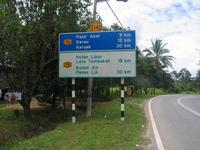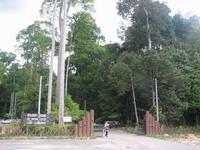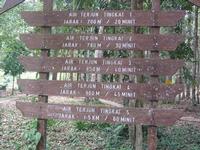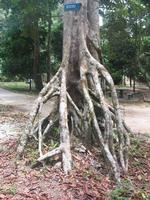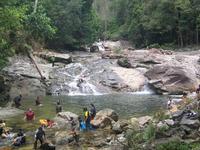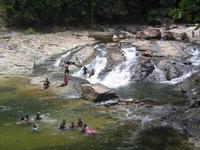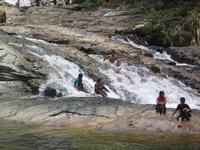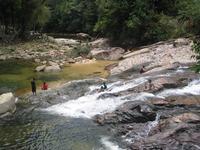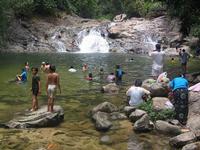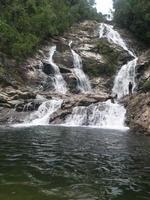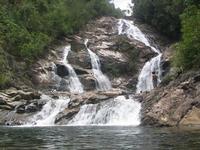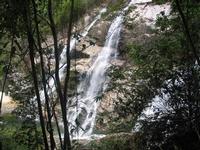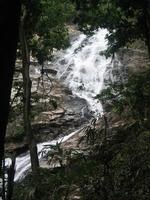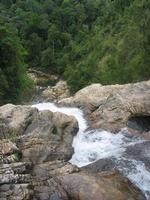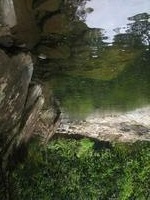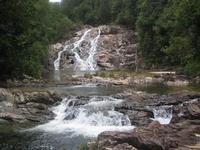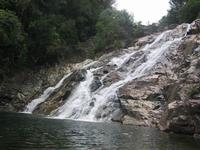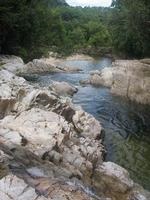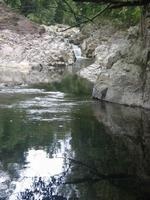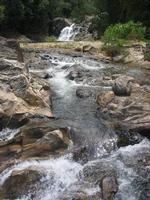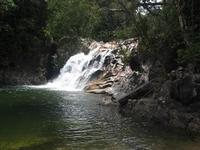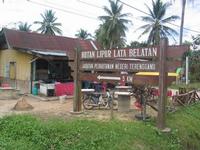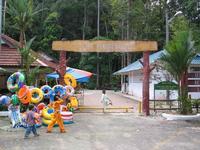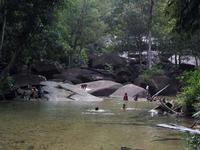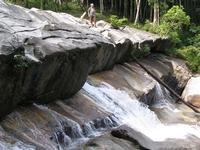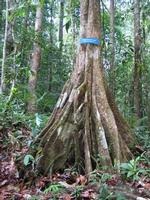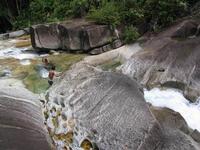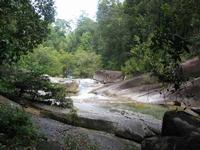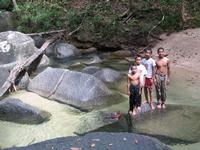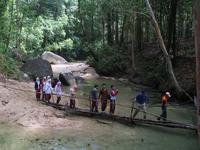 | |||||
| |||||
Interesting Places In Terengganu that you have to visit
all the places above i had been there..hope may be helpful to you for that finding some place in terengganu.enjoy it....
Sabtu, 21 November 2015
pulau perhentian,besut,terengganu
lata tembakah,besut,terengganu
Lata Tembakah
| State | Terengganu |
| Location | 25 km south of Jertih |
| Coordinates and map | N05° 35.17' E102° 26.83' |
| Water Source | Stream |
| Waterfall Profile | Vertical Falls & Cascades |
| Accessibility | Nature park |
The Tembakah Waterfalls are probably the most impressive falls of Terengganu. The Hutan Lipur Lata Tembakah is clearly signposted and can be reached from Jertih. Coming from K. Terengganu a shortcut is possible by taking the T142 near Kg Jabi
|
This is the sign you will see, when you come from K. Terengganu
|
The park is well maintained with many facilities
|
A timetable gives time and distance to the falls, but it is not very accurate
|
The first waterfalls are actually more like cascades. They have nice, large pools, which make them perfect for family outings. Not surprisingly, this park can be crowded!
|
The trees along the trail are marked with their names.
|
The first cascade
|
Some of the cascades can be used as (bumpy) slides.
|
Our visit took place on a weekday, so at first we were surprised by the number of visitors. Then it became clear that nearby Kelantan was celebrating the sultan's holiday!
When you follow the trail along the river, you reach the main fall of the park. It is number 4 of the list.
|
The nr 4 waterfall is very impressive
|
It is a tall fall with an estimated altitude of 80 meters
|
From this fall you can continue to the upper falls.
|
To reach the upper falls, there are two possibities. First, you can choose the jungle trail, which is clearly signposted. The other way is to scramble upwards at the right side of the main fall. Interesting but not easy.
|
View of the mail fall, seen when scrambling uphill
|
At the top of the main fall. Deep down the crowd of visitors is visible.
|
After the main fall there are some quiet stretches
|
The upper falls are also very impressive and as it takes some effort to reach them, they will be quiet even when there is a crowd.
|
A slightly smaller brother of the main fall
|
Also here a beautiful pool
|
One of the quiet stretches
|
|
quiet....
|
and wild....
|
The last waterfall
|
rantau abang,dungun,terengganu
Rantau Abang
| Day Tours ...
 |
At 22km north of K.Dungun and 80km south of K.Terengganu, is probably the most talked about tourist spot in Terengganu. There was a time when a great number of giant leatherback turtles came to Rantau Abang to lay their eggs between May and August. (Peak egg laying months are June and July). The beach terrain here is favourable as it has a steep and deep slope so that the turtle can 'land' straight up the beach. If the beach has a shallow and gradual slope, the turtle would have to spend much of her energy wading through a fair distance before finding a suitable nesting site closer to the vegetation line. She must conserve as much energy as possible for what she has to do later. The mother turtle comes up in the cover of night to lay her eggs. Leatherback turtles can grow to a length of 2m and easily weigh up to 500kg. Unlike other turtles species who have hard bony shells, they have soft, leathery shells or carapace with 7 ridges running longitudinally down. The design and shape of the carapace reduces water friction and together with the long flippers helps the turtle propel smoothly through water. This is a more suitable design, for these long distance swimmers have to travel across great oceans every 2 to 3 years to return to the same breeding ground. It is believed that the long distance travel is related to seasonal drifts of the jellyfish.
 |
Graceful reptiles in the water, on land their weight and shape can be cumbersome. Each female nests between 5 to 9 times per season and each nest has between 50 to 140 eggs. The male, on the other hand, never comes ashore. Once the mother turtle has laid her eggs and covered them, she rests for a bit and then makes her way back into the sea. Exhausted from the ordeal, she swims out into the open sea to feed and replenishes her energy. This is the time when she is most vulnerable to shark attacks. There have been reports of leatherbacks with disfigured fins and wounds caused by sharks.
In the 1950's, there were around 11,000 nestings reported at Rantau Abang. By 1999, it had dropped to fewer than 10 nestings. There are a number of factors attributed to the sharp drop in numbers. In the early years when there were no rangers monitoring the beach, local tourists were seen riding on the turtles, pulling their flippers, shining flashlights into the poor, suffering creature's eyes and all sorts of gross misconduct. Turtles are extremely sensitive creatures and are not accustomed to such stress. On top of the terrible treatment on land, high activity of trawlers scouring the coastal waters and pollution lingering around the coastline were added dangers. Leatherbacks and other turtles were often trapped in nets that slowly drowned them, killing 100,000s every year worldwide. Adding to the turtles' misfortunes, the turtle eggs were collected by locals to sell in the markets. The locals claim that these eggs have aphrodisiac and beautifying properties although there is no scientific proof for these claims. It is reported that their nutritional value is even less than that of a chicken egg. Turtle eggs are still sold at markets around Terengganu and will continue to do so until authorities realise the importance of protecting the species at every stage of its lifecycle and development.
 |
Their numbers are dwindling. Without the turtles around, Rantau Abang itself has fallen into shambles. Many of the outlets and some resorts have been abandoned. What used to be a busy seaside resort has now become a little more than a place for gas refill.
If only there was more concerted effort to educate the people on the sensitivities of these turtles then perhaps that could in a small way help arrest the disappearing population.
 |
For more information on the leatherbacks, there is a Turtle Information Centre managed by the Department of Fisheries at Rantau Abang. The rangers have been patrolling the beaches to ensure safety for the turtles when they come onto shore to lay their eggs. They have also released 100,000s leatherback hatchlings back into the sea through a series of successful incubation and release programmes. The centre is open every day except Friday and public holidays.
If however, you are truly interested to learn and live with turtles, you can opt to stay at Pulau Redang with the turtle researchers for a week (at a cost of course!) under the SEATRU or the Sea Turtle Research Unit of the University College of Science and Technology programme. Dr Chan and Mr. Liew from Universiti Putra Malaysia (UPM) run this programme and they have a turtle breeding centre at the Uni. A couple of interesting albino hawksbills are kept in tanks at the centre. However, this is not open to the public so if there is any interest please contact Dr. Chan at (6)09-668 3251 or Mr Liew at (6)09-668 3250 or visit the website atwww.kustem.edu.my/seatru
Accommodation at Rantau Abang
Rantau Abang has seen its heydays. Today, many bypass this place, in search of other interests. The turtles seldom land on the beaches due to the excessive harassment from local visitors and fishermen. Most of all, these turtles are dying off and if you get to see one, you may be the last few people to ever see them. Soon there will be none left.
The town seems more like a ghost town. To recommend a place to stay would be difficult for there is no telling how long the motels will sustain themselves for lack of visitors. However, the beaches are beautiful.. a dream really and extremely quiet. Just as it was years ago...
pulau redang,kuala terengganu,terengganu
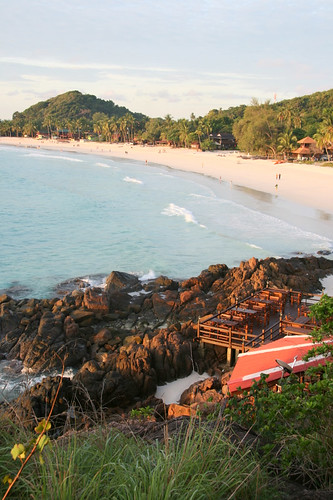
Redang Island is still a very much covered by the Rainforest, thank for the government and local ISLAND effort. The ideal time for going for a trekking is at a round 7'o'Clock in the morning. Where you will find the water very fresh and protected by the strong heat of the morning mist. The track that you can find here is about 2.5 km trail that leads from Pasir Panjang a beautiful beach in Teluk Dalam, where nearby ...
kampung cina,kuala terengganu,terengganu
Chinatown (China)
address: Jalan Bandar, Kuala Terengganu

the Chinatown gate on Jalan Bandar
KT's Chinatown is located along Jalan Bandar. It is small but charming with colorful shophouses and still has the traditional feel with small stores, cafes and restaurants
KT's Chinatown is located along Jalan Bandar (formerly known as Jalan Kampung Cina) at the river mouth of the Terengganu River that empties into the South China Sea. If you overnight at the hotel / hostel in town and wish to pay the island a visit, it is convenient and easy as the boats depart from the jetty next to Chinatown to the islands. The town is small but charming with colorful shophouses along both sides of the road that carries traditional flavor. Small grocery shops, a morning market, butcher shops, hardware shops, kopitiams (literally means coffee shops), cafes, restaurants and so on can be found in this humble little town. The kopitiams, cafes and restaurants offer local delicacies from mostly Chinese, but also Malay and Indian food. Start your day in town with an empty stomach and you will be sure to be satisfied with the food at the end of the day.
lata belatan,besut,terengganu
Lata Belatan
| State | Terengganu |
| Location | 15 km South East of Jertih |
| Coordinates and map | N05 ° 38.26 'E102 ° 35.36' |
| Water Source | Stream |
| Waterfall Profile | Cascades |
| Accessibility | From the carpark |
The Forest Lata Belatan is clearly signposted and easily accessible from the Federal Road nr 3. It is a well maintained recreational park, very suitable for families with children.
|
A clear sign on the road nr 3 shows the way
|
Food stalls, shops, all facilities are available
|
The huge boulders are characteristic for Belatan.
|
In the dry season the water flow is very limited. In the rainy season the fall will be more impressive.
|
There was not much water during our visit
|
Nature trails give information about the forest trees
|
With so little water, the place is safe, but take care with the rocks, which can be slippery.
|
Above the fall, the trail continues in the jungle
|
The stream flows quietly here
|
Note again the huge boulders
|
From here you can start the jungle trekking
|
pantai bukit keluang,besut,terengganu
|
Langgan:
Catatan (Atom)
